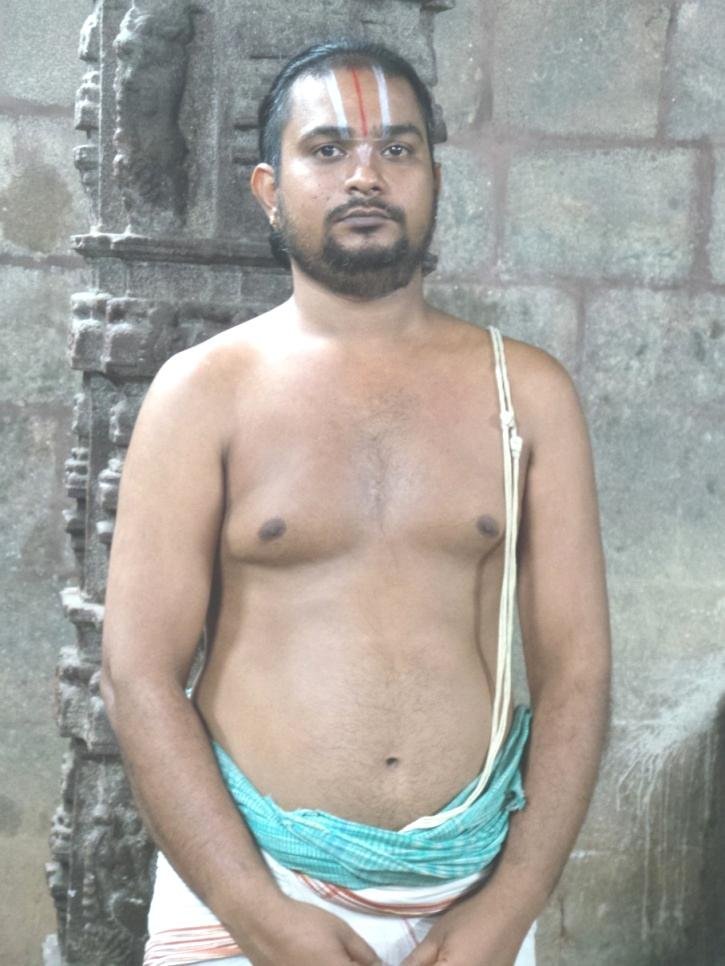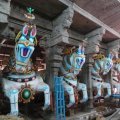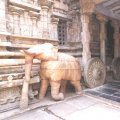Sculptures in temples in Kumbakonam: photo 6
Photo 6 of 640 in Gallery: Sculptures in temples in Kumbakonam

Image title: Figure 6. Bhattacarya R.Chakravarty
Description of the photo
Second person interviewed: Bhattacarya R.Chakravarty
Designation–Bhattacarya at the Sarngapani
Temple Date of interview–28.10. 2013
1. Can you tell something about the history of this temple?
A. This temple is the third one out of the 108 Divya Desams which are sung by the Alvars. Out of the 12 Alvars 7 have sung about Lord Sarngapani and done Mangalasasanam. Tirumalisai Alvar requested the Lord to rise and talk. So the Lord tries to get up. Hence as an answer to his devotee’s prayer the Lord takes the Uttanasayi position as if trying to get up. In Srirangam he is in Bhogasayanam. Here, Tayar incarnated in a Lotus with 1000 petals in the Puskarini Potramarai Kolam [Kola] which is behind the temple. She was brought up by Hemarsi.The tank is also called as Hemapuskarini. Tayar Komalavalli desired and did penance to marry the Lord.
Hence the Lord is said to have arrived in a chariot of elephants and horses to marry her. The Garbha Graha Sannidhi is for this reason shaped like a chariot drawn by elephants and horses. Lord Sarngapani then wedded Tayar Komalavalli. After this event the devotees prayed to him to stay on here. Hence as an answer to their prayers the Lord settled here in this temple. The temple is built in such a way that one has to worship Tayar Komalavalli Mahalaksmi and then have a Darsana of the Lord. The Lord here is called by several names–Aravamudan, Aparyaptamudan, Sarngaraja, Sarngapani and Sarngesan. Here Lord Sarngapani is with Sridevi and Bhumidevi. Mulasthana Murti is Uttanasayana Murti. Utsava Murti is Caturbhujam [Caturbhuja] (with four hands) holding Sankha, Cakra, Gadai, Sarngam, Khadgam [Khadga] and Banam [Bana]–the first three being attached Ayudhams and the other three being detachable Ayudhams.
2. How many hands does Tayar have and what does she hold?
A. Here there are three Tayar Murtis–Mula Sthana Tayar who is called Komalavalli, Utsava Murti Tayar also called Komalavalli and the third one is Bala Komalavalli Tayar. Mula Sthana Tayar and Utsava Murti Tayar have four hands. Two back hands hold Padma and the front hands are in Abhaya (right) and Varada (left). She is standing on a Lotus.
3. What is the structure of the Garbha Graham here?
A. It is shaped like a chariot drawn by elephants and horses since the Lord came from Vaikuntam [Vaikunta] to seek her hand. The Garbha Graham [Graha] has two doors–Uttarayanam [Uttarayana] and Daksinayanam. This temple is also called as Bhuloka Vaikuntam.
4. Is there any special name given to the Garbha Graha Vimana?
A. It is called Vaitika Vimanam. The Vimanams are specific to the temples.
5. How many Prakarams are there in this temple?
A. There are 4 Prakarams–One is the outside big Vidi Prakaram, the second is as soon as you come in, the third is around both the Lord and Tayar together and fourth is only around Tayar.
6. What structures do you find in the Prakarams?
A. In the Vidi Prakaram [Prakara] is the Raja Gopuram, immediately inside in the second Prakaram [Prakara] is the Vadya Mandapam.
7. How many Mandapams are there in the temple in all?
A. Ardha Mandapam [Mandapa] outside the Garbha Graham [Graha] consisting of 12 pillars, Maha Mandapam, Nrtta Mandapam, Vadya Mandapam, Sopana Mandapam and Dhvaja Stambha Mandapam. So totally there are 7 Mandapams in all. Just outside the
Garbha Graham is Ardha Mandapam, outside the Ardha Mandapam is Maha Mandapam, then outside is Nrtta Mandapam and Vadya Mandapam, then Sopana or Unjal Mandapam and then finally Dhvaja Stambha Mandapam.
8. Is there any Sthala Vrksa in this Kovil?
A. There is no Sthala Vrksa in this temple.
9. How many times is Puja done in this temple?
A. Arukala Puja (6 times) is performed in this temple.
Visvarupam [Visvarupa] at morning 7 am. He is offered Palam [Pala] (fruits) and Pal (Milk).
Tiruvanandal at 8.30 am. Tayirsadam (curd rice) is offered.
Tiruvaradanam between 9.00 and 9.30am. Venpongal is offered. At this time
Tiruppavai is sung.
Uccikalam [Uccikala] at 12.30 pm. Sudhannam, Murukku, Vadai and Appam [Appa] is offered.
Sayaraksai between 6 and 6.30 pm. Dosai and Cundal is offered.
Akalam [Akala] or Irendamkalam–Between 7.30 and 8.00 pm. Again Venpongal is offered.
Ardhajamam [Ardhajama] between 9.00 pm and 9.30 pm. Sakkarairpongal is offered.
10. Who are the Utsavamurtis here?
A. Sarngapani, Sridevi and Bhumidevi. Sridevi is on right side of the Lord and Bhumidevi is on left side of the Lord. Tayar Kovil Utsavamurti is Komalavalli Tayar.
11. Why is the Mulavar Vigraham always black?
A. The stone is Sila Vigraham. It is carved with ornamentation. No Abhisekam [Abhiseka] is done to the Mulavar since he is in Sayana position. Only Tailam [Taila] is applied on the stone to preserve. Abhisekam is done to Tayar since she is standing. The Tirumanjanam or Abhisekam [Abhiseka] is done to Utsavar only three times in a year-on Adi Masam Jestabhisekam, Dasami, Ekadasi.
12. How many Utsavams are celebrated in the temple?
A. Two times Brahmotsavam [Brahmotsava] is celebrated–in Cittirai Masam and from end of Margali Masam.
Dolotsavam in Kartigai Masam.
Adhyana Utsavam in Margali Masam–Rapattu and Pagalpattu. Brahmotsavam [Brahmotsava] separately for Tayar in Panguni Masam–Ter Utsavam. Pavitrotsavam [Pavitrotsava] for 7 days to ward off evil and for Santi.
Nityotsavam [Nityotsava] is celebrated each month called Pancaparavam [Pancaparava] for 15 days–Masaparuppu, Ammavasai, Vellikalamai, Cittranakstram, Uttaram, Sravananaksatram–all are celebrated.
So in a year in all the twelve months there are festivals celebrated.
13. What are the Sannidhis found in this temple?
A. Patala Srinivasar Sannidhi, Visvaksenar or Senai Mudalvar Sannidhi,
Mettu Srinivasar Sannidhi, Citra Srinivasar Sannidhi, Andal Sannidhi, Rajagopala Sannidhi, Ramar Sannidhi, Navanita Krsnar Sannidhi, Hemarsi Mandapam [Mandapa] near the Potramarai Kolam. If you climb down the steps of Garbha Graham [Graha] there are along the wall–Sthambha Narasimhar, Yudha Narasimhar, Ugra Narasimhar and Yoga Narasimhar; after that there is Vaikunthanathar, Ulagalanda Perumal, Gajendravaradan and Venugopalan.
14. Were Devadasis associated with this temple in the olden days?
A. Yes it seems there were. After the Utsavamurtis completed Vidi Pradaksinam [Pradaksina] or Prahara Pradaksinam, the Dasis would give the Ghata Dipam [Dipa] to offer to the Lord through Nrtya. This Nrtya would be performed under the Kodi Maram. The Arati which is done to ward off evil eye is called Ghata Diparati. Since it is shaped as a Kumbham [Kumbha] it is called Kumbharati or Ghatarati.
15. Do you receive salary from the state government?
A. No, this is tradition handed down. So government gives nothing. But they give us groceries like rice, Dal, sugar etc on a monthly basis and some funds are given to us which is donated by the people or collected for Arcanai.
Gallery information:
Kumbakonam is considered as one of the holiest places in Tamil Nadu and is known for its temples and Mathas (monasteries which were centres of Brahmanical learning). These photographs depict the connection between the sculptures in the temples and Natya Shastra and related texts dealing with iconography.
Photo details:
High resolution:
Download file
Size: 79.29 KB
Resolution: 725 x 966
© Copyright: see gallery source

